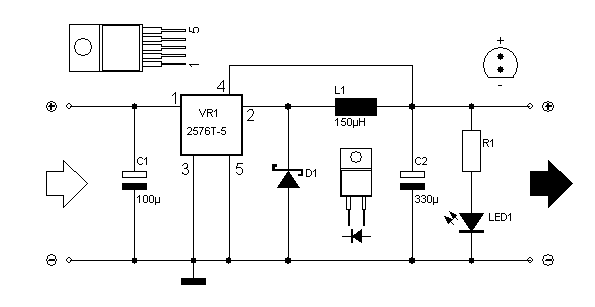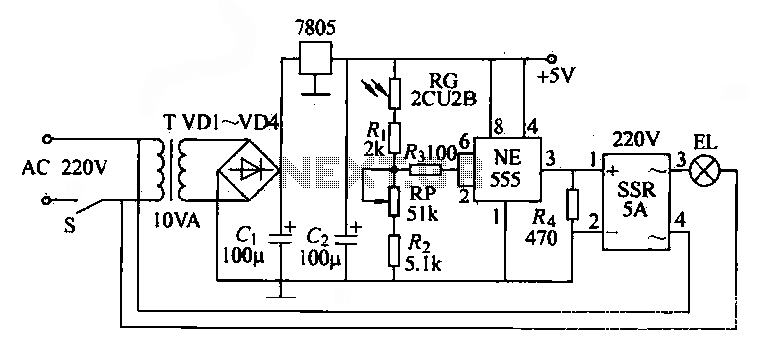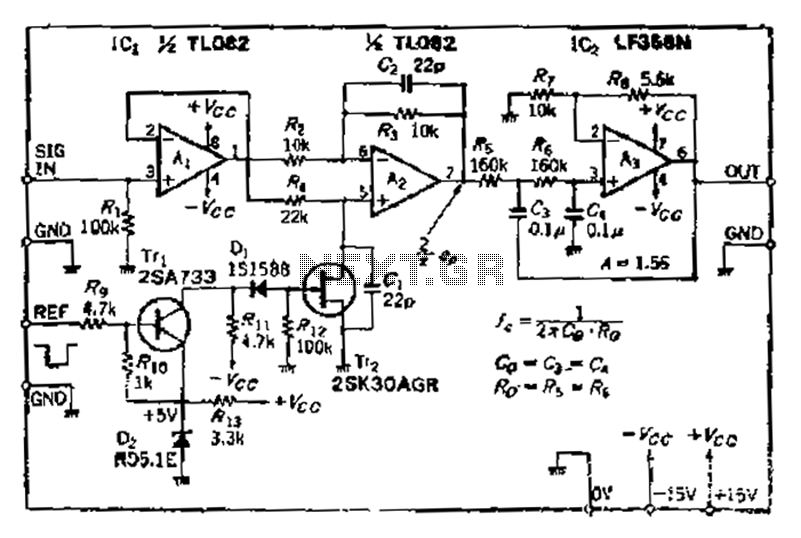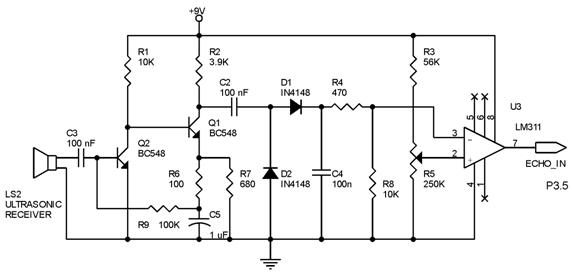
Ultrasonic switch
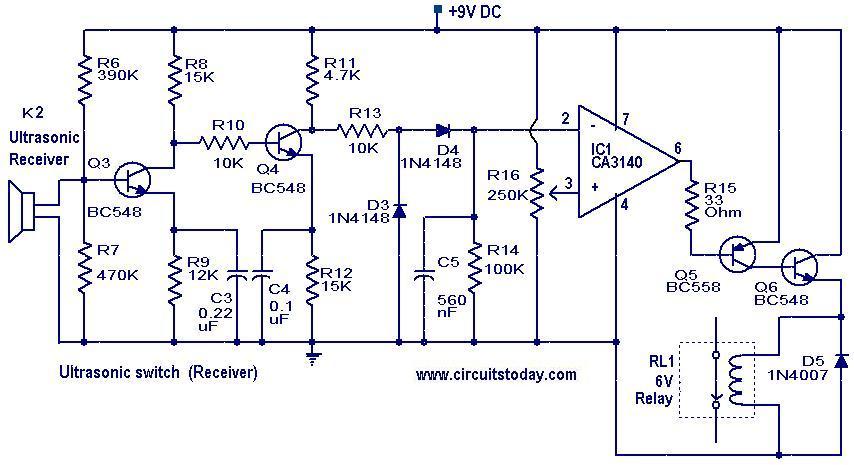
The transmitter section of the circuit is built around IC1 (NE 555), which is configured as an astable multivibrator operating at 40 kHz. The output from IC1 is amplified by a complementary pair of transistors (Q1 and Q2) and transmitted through the ultrasonic transmitter K1. A push-button switch S1 is used to activate the transmitter. The receiver employs an ultrasonic sensor transducer (K2) to detect the ultrasonic signals. When an ultrasonic signal reaches the sensor, it generates a proportional voltage signal at its output. This weak signal is amplified by a two-stage amplifier circuit consisting of transistors Q3 and Q4. The output of the amplifier is rectified by diodes D3 and D4. The rectified signal is fed to the inverting input of an operational amplifier (op-amp) configured as a comparator. Whenever an ultrasonic signal is detected by the receiver, the output of the comparator activates transistors Q5 and Q6 to drive a relay. Consequently, the load connected via the relay can be switched on or off. Diode D5 serves as a freewheeling diode.
The circuit operates in two primary sections: the transmitter and the receiver. The transmitter utilizes the NE 555 timer IC configured in astable mode, generating a continuous square wave at 40 kHz. This frequency is suitable for ultrasonic applications, ensuring that the transmitted signal is above the audible range for humans. The output from the NE 555 is fed into a pair of transistors (Q1 and Q2), which serve as a push-pull amplifier configuration, effectively boosting the signal strength before it is emitted by the ultrasonic transmitter (K1). The push-button switch (S1) allows for manual activation, ensuring that the transmitter operates only when desired.
In the receiver section, the ultrasonic transducer (K2) is responsible for detecting the ultrasonic waves reflected from nearby objects. Upon receiving an ultrasonic signal, K2 generates a small voltage proportional to the intensity of the signal. This signal is often too weak for further processing, which is why it is amplified using a two-stage transistor amplifier (Q3 and Q4). The amplified output is then rectified using diodes D3 and D4, converting the AC signal into a DC voltage suitable for further analysis.
The rectified voltage is sent to the inverting input of an op-amp configured as a comparator. This setup allows for threshold detection; when the voltage exceeds a certain level, indicating the presence of an ultrasonic signal, the comparator output switches state. This change in output activates transistors Q5 and Q6, which control a relay. The relay can switch larger loads, enabling practical applications such as activating alarms or other devices based on the presence of an object detected by the ultrasonic signal.
Diode D5 plays a critical role in protecting the circuit by allowing current to flow back to the power source when the relay coil is de-energized, preventing potential damage to the transistors from back EMF generated by the relay coil. Overall, this circuit design demonstrates an effective method for utilizing ultrasonic technology in various applications, including proximity sensing and object detection.The transmitter part of the circuit is build around IC1(NE 555). The IC1 is wired as an astable multi vibrator operating at 40KHz. The output of IC1 is amplifier the complementary pair of transistors ( Q1 & Q2) and transmitted by the ultrasonic transmitter K1. The push button switch S1 is used the activate the transmitter. The receiver uses an ultras onic sensor transducer (K2) to sense the ultrasonic signals. When an ultrasonic signal is falling on the sensor, it produces a proportional voltage signal at its output. This weak signal is amplified by the two stage amplifier circuit comprising of transistors Q3 and Q4.
The output of the amplifier is rectified by the diodes D3 & D4. The rectified signal is given to the inverting input of the opamp which is wired as a comparator. When ever there is an ultrasonic signal falling on the receiver, the output of the comparator activates the transistors Q5 & Q6 to drive the relay. In this way the load connected via the relay can be switched. The diode D5 is used as a free wheeling diode. 🔗 External reference
The circuit operates in two primary sections: the transmitter and the receiver. The transmitter utilizes the NE 555 timer IC configured in astable mode, generating a continuous square wave at 40 kHz. This frequency is suitable for ultrasonic applications, ensuring that the transmitted signal is above the audible range for humans. The output from the NE 555 is fed into a pair of transistors (Q1 and Q2), which serve as a push-pull amplifier configuration, effectively boosting the signal strength before it is emitted by the ultrasonic transmitter (K1). The push-button switch (S1) allows for manual activation, ensuring that the transmitter operates only when desired.
In the receiver section, the ultrasonic transducer (K2) is responsible for detecting the ultrasonic waves reflected from nearby objects. Upon receiving an ultrasonic signal, K2 generates a small voltage proportional to the intensity of the signal. This signal is often too weak for further processing, which is why it is amplified using a two-stage transistor amplifier (Q3 and Q4). The amplified output is then rectified using diodes D3 and D4, converting the AC signal into a DC voltage suitable for further analysis.
The rectified voltage is sent to the inverting input of an op-amp configured as a comparator. This setup allows for threshold detection; when the voltage exceeds a certain level, indicating the presence of an ultrasonic signal, the comparator output switches state. This change in output activates transistors Q5 and Q6, which control a relay. The relay can switch larger loads, enabling practical applications such as activating alarms or other devices based on the presence of an object detected by the ultrasonic signal.
Diode D5 plays a critical role in protecting the circuit by allowing current to flow back to the power source when the relay coil is de-energized, preventing potential damage to the transistors from back EMF generated by the relay coil. Overall, this circuit design demonstrates an effective method for utilizing ultrasonic technology in various applications, including proximity sensing and object detection.The transmitter part of the circuit is build around IC1(NE 555). The IC1 is wired as an astable multi vibrator operating at 40KHz. The output of IC1 is amplifier the complementary pair of transistors ( Q1 & Q2) and transmitted by the ultrasonic transmitter K1. The push button switch S1 is used the activate the transmitter. The receiver uses an ultras onic sensor transducer (K2) to sense the ultrasonic signals. When an ultrasonic signal is falling on the sensor, it produces a proportional voltage signal at its output. This weak signal is amplified by the two stage amplifier circuit comprising of transistors Q3 and Q4.
The output of the amplifier is rectified by the diodes D3 & D4. The rectified signal is given to the inverting input of the opamp which is wired as a comparator. When ever there is an ultrasonic signal falling on the receiver, the output of the comparator activates the transistors Q5 & Q6 to drive the relay. In this way the load connected via the relay can be switched. The diode D5 is used as a free wheeling diode. 🔗 External reference
